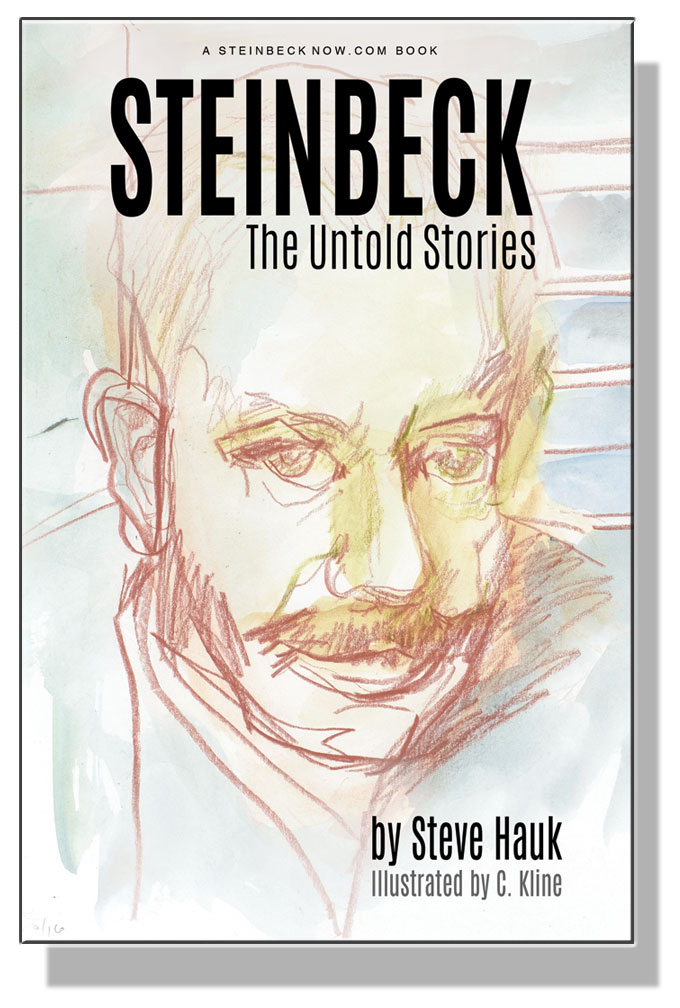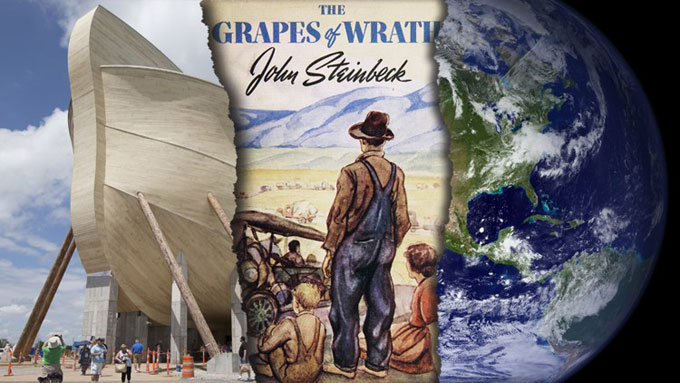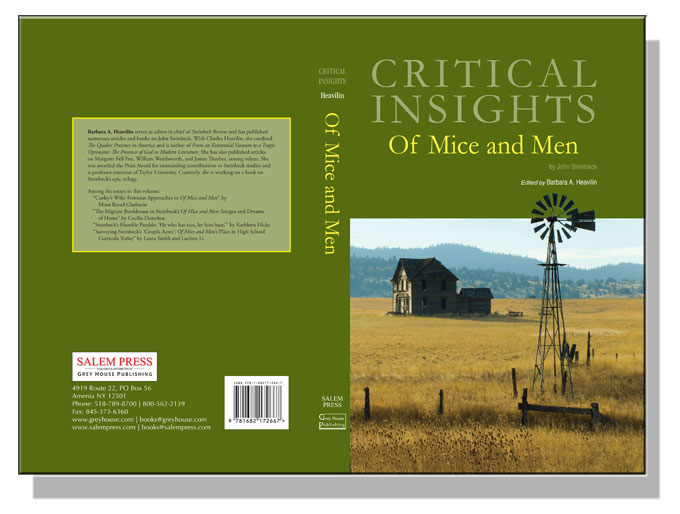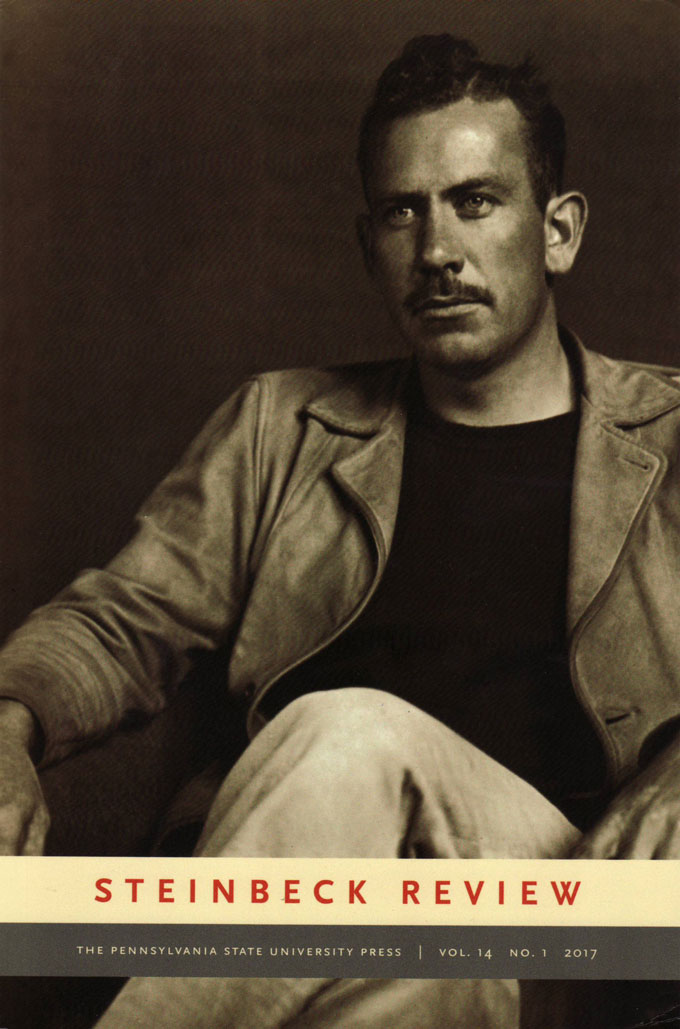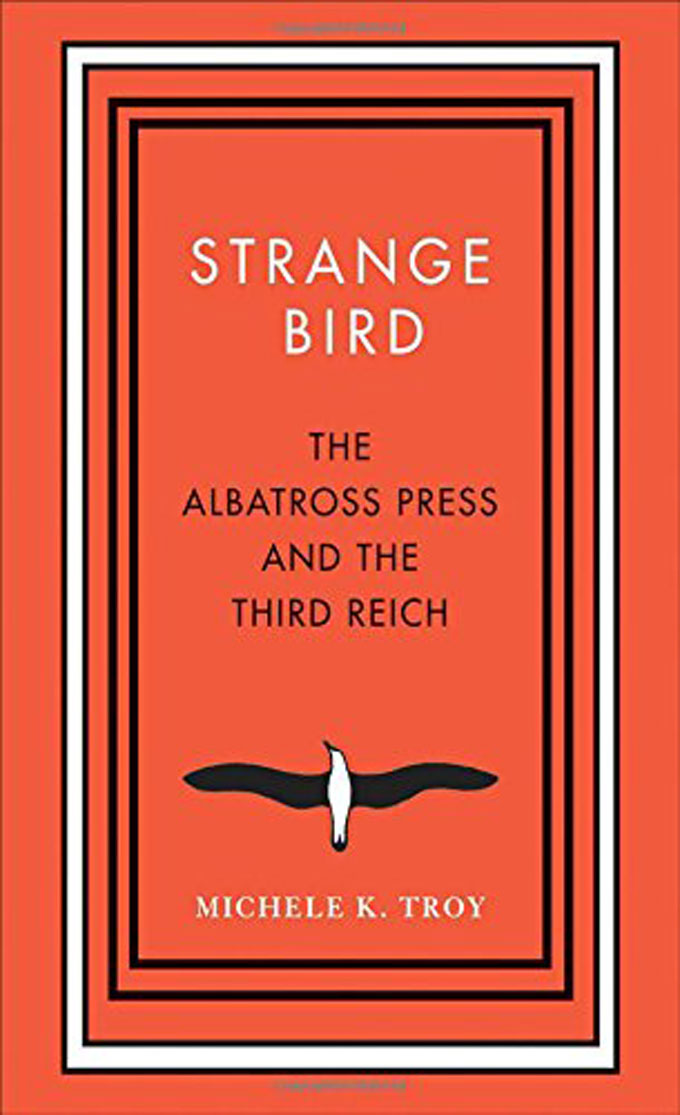Most Steinbeck books are fiction, but the Salinas, California native also wrote poetry in school and got better grades in versification than he did in short story writing at Stanford. This year’s Big Read poetry slam at the National Steinbeck Center in Salinas honors Steinbeck’s gift for verse, and the author’s sensitivity to race and class, with an invitation to writers to compose a poem in response to Claudia Rankine’s Citizen: An American Lyric, a 2017 Big Read book selection that reflects on racism in America. This is the fourth year the National Steinbeck Center has participated in the Big Read, a community literacy initiative of the National Endowment for the Arts, but the first to feature a poetry slam—the idea of Jenna Garden, a Stanford student and National Steinbeck Center summer intern. Poems submitted by September 5 will be read aloud to a panel of judges who will award cash prizes on September 8. This year’s Big Read in Salinas, California also features a film series at the Maya Cinemas multiplex. The series kicks off August 28 with Lifeboat, the 1944 movie for which Steinbeck, who wrote the script, did not want credit because of racial stereotyping by the director Alfred Hitchcock, a man Steinbeck privately described as a middle-class English snob.
Steinbeck Now Publishes First Print Book and eBook
Steinbeck: The Untold Stories, a book of short stories about John Steinbeck’s life, family, and friends, has been published by SteinbeckNow.com in print and eBook format. Written by Steve Hauk, a playwright and fiction writer from Pacific Grove, California, the 16 short stories dramatize incidents in Steinbeck’s life—some real, some imagined—that take place over six decades, from the author’s childhood in Salinas, California to the years in New York, where his circle of family and friends included Burgess Meredith, Joan Crawford, and Elaine Steinbeck, the widow with whom Hauk had a memorable conversation 30 years after John Steinbeck’s death. Illustrated by Caroline Kline, an artist on California’s Monterey Peninsula, Steinbeck: The Untold Stories represents a milestone in the mission of SteinbeckNow.com to foster fresh thinking and new art inspired by Steinbeck’s life and work. If you are in a position to review or write about the book for publication in print or online, email williamray@steinbecknow.com for a review copy. Please identify the print publication or website, the date when your print piece or post will appear, and whether you prefer print or eBook format. Steinbeck: The Untold Stories is available through Amazon.com, in Monterey-area bookstores, and at Hauk Fine Arts in Pacific Grove and the National Steinbeck Center and Steinbeck House in Salinas, California.
Steve Hauk will autograph copies from 11:30 a.m. till 12:15 p.m. on Saturday, November 25, 2017, at the Pilgrim’s Way Community Bookstore on Dolores Street between 5th and 6th Streets in Carmel, California.
The Grapes of Wrath Inspires Lancaster Singer-Songwriter
A young singer-songwriter in Lancaster, Pennsylvania recently wrote a song inspired by The Grapes of Wrath, joining a line of Steinbeck-loving singer-songwriters stretching all the way back to Woodie Guthrie. Jenelle Janci, staff writer for Lancaster Online, notes the most recent visitation of the Grapes of Wrath muse in her July 5 profile of Sean Cox, a popular club and wedding musician who recently cut his first solo record. “Letters to the Light”—the set Cox sang for his recent solo debut at a downtown Lancaster, Pennsylvania venue—sounds very different from the punk and garage-band music Janci says the enterprising singer-songwriter performed as a teenager. Steinbeck, an author with eclectic musical tastes who admired artistic courage, would approve.
Photo of Sean Cox by Joey Ulrich courtesy WITF.
The New Florida Climate of No-Nothing Culture Rejects The Grapes of Wrath: Satire
Frank Cerabino, the humor writer for the Palm Beach Post newspaper best known for book-length put-downs of condo captains and crooked politicians, seized on The Grapes of Wrath to satirize Sean Hannity, intelligent design, and Florida climate deniers in a July 7 column—“Florida’s evolution to complainer’s paradise for public schools”—excoriating the new Florida law authorizing state hearing officers to consider requests from “any resident, regardless of whether he or she has children in the public school system, to instigate a formal challenge to any textbook, library book, novel, or other kind of instructional material used in a public school.” Here is the letter from an imaginary retiree with too much time on his hands demanding the removal of The Grapes of Wrath from a South Florida school district.
Dear Unbiased and Qualified Hearing Officer:
It has come to my attention that some public school libraries in this district contain the novel “Grapes of Wrath” by John Steinbeck, a well-known socialist who visited the Soviet Union in 1947 and espoused biased opinions about capitalism.
By allowing students to read Steinbeck’s “Grapes of Wrath” you are exposing them to a work of art that shines a harsh light on American history and its ideals.
This is shameful, and obviously part of the school board’s liberal agenda. Which is why me and others in my morning Einstein’s Bagels discussion group hereby demand that unless you balance Steinbeck’s “Grapes of Wrath” in school libraries with Sean Hannity’s inspiring book, “Let Freedom Ring: Winning the War over Liberalism” we will be requesting a public hearing.
We’re not putting up with the school district’s Saul Alinsky tactics!
Grapes of Wrath Parody Spoofs Steinbeck’s Style
John Steinbeck famously refused to let style dictate subject in his writing. So fans of The Grapes of Wrath could laugh without feeling guilty when they read “Excerpts from Steinbeck’s Novel About the 2013-17 California Drought” by Riane Konc, a pitch-perfect parody of the turtle scene from The Grapes of Wrath published online by The New Yorker. For great writers, imitation really is a form of flattery, and the humorous send-up of Steinbeck’s full-throated style from Konc, a youthful contributor to the magazine’s humor section, also manages a shout-out to the ecological truth embedded in Steinbeck’s greatest novel. Here’s a sample of paying tribute while making fun of a style John Steinbeck chose not to repeat, despite urging:
When 2015 was half gone, and the sun climbed high above the 405 and stayed, an In-N-Out wrapper blew down the highway like a tumbleweed, and a land turtle lumbered onto the road and began to cross. . . . A woman screamed—something guttural, a noise she hadn’t made since Lindsey suggested that maybe they just pack up and try Brooklyn—and dashed into the road. She grabbed her turtle and screamed again, “Banksy!,” for that was his name. His name was Banksy, and he was a rescue, not that the man driving the Tesla would care to ask, or know the difference between a rescue turtle and one from a mall.
As they say in Brooklyn when recommending guilt-free pleasure: Enjoy.
Critical Insights into John Steinbeck’s Of Mice and Men
Critical Insights: Of Mice and Men, a collection of literary criticism devoted to John Steinbeck’s Great Depression novella, is now available at Amazon.com. Edited by Barbara A. Heavilin with an introduction by Robert DeMott, it includes essays by Nick Taylor, Brian Railsback, Kathleen Hicks, Laura Smith, Luchen Li, Mimi Gladstein, Tom Barden, Danika Čerče, Cecilia Donahue, and Richard E. Hart, along with a Steinbeck chronology and a bibliography of scholarly writing about Of Mice and Men, a work that re-entered political discourse when the so-called Lenny rule was cited by defenders of capital punishment in a Texas case that recently made its way to the United State Supreme Court. Barbara Heavilin, a professor emeritus at Taylor University and the executive editor of Steinbeck Review, said this about the book’s relevance and the significance of literary criticism devoted to its understanding and appreciation: “I particularly wanted Critical Insights: Of Mice and Men to provide fresh, new insights on this novella, with articles provided by reputable Steinbeck scholars writing on their specialties. Mimi Gladstein, for example, writes on feminism, and Robert DeMott provides an insightful overview, among other well-known experts in the field of Steinbeck studies.”
Steinbeck Review Features Literary Criticism, History, Bibliography, and News
Penn State University Press recently released the first of two issues of the academic journal Steinbeck Review to be published in 2017. Along with news and reviews, it features essays in literary criticism by Gavin Jones, professor of English at Stanford University; Barbara A. Heavilin, editor of Critical Insights: Of Mice and Men; Harold Augenbraum, former executive director of the National Book Foundation, presenter of the National Book Award; Cecilia Donahue, a retired university teacher and a contributor to the Literary Encyclopedia database; Netta Bar Yosef-Paz, a literature teacher at Kibbutzim College, Israel’s largest college; Chaker Mohamed Ben Ali, a doctoral student at the University of Skikda, Algeria; and Hachemi Aboubou, assistant dean at Batna Benboulaid University, also in Algeria. The issue includes reviews of Citizen Steinbeck: Giving Voice to the People, a book of literary criticism by Robert McPartand, and Monterey Bay, a novel, as well bibliographies of recent books, articles, theses, and dissertations on John Steinbeck’s life and work. An annual subscription costs $35 and includes both print and digital editions of Steinbeck Review.
John Steinbeck Loved This Family Home in Watsonville, California, and So Will You
For John Steinbeck, moving on in life meant leaving family homes—and friends—behind in California, starting with Salinas, where the Steinbeck family home on Central Avenue has become a living museum made possible in part by gifts of memorabilia from John Steinbeck’s oldest sister, Esther. The 11th Street cottage in Pacific Grove where Steinbeck often stayed when he was poor, single, or hurting remains in the extended family, but the pair of houses in Los Gatos where he lived with his wife Carol and wrote the books that made him famous both belong to strangers now. The bungalow he bought on Eardley Avenue in Pacific Grove when the marriage faltered and he needed writing space belongs to a bed and breakfast today, but it can be rented and is readily seen from the street. So is the historic adobe in Old Monterey that Steinbeck purchased with his second wife before abandoning California for New York, where he chose to live with Elaine, his third wife, until he died.
Visit Rodgers House at Santa Cruz County Fairgrounds
Through it all, the family home John Steinbeck kept coming back to was his sister Esther’s house in Watsonville, California, the Pajaro Valley farming community nestled between the mountains and the sea northwest of Salinas, along the Monterey-Santa Cruz county line. Esther moved there to teach before marrying Carrol Rodgers, a prosperous rancher-farmer, and raising three daughters who called John Steinbeck uncle. The Rodgers family home on East Lake Avenue, built in the 1870s by Esther’s husband’s forebears, was bigger than any of the houses owned by Steinbecks in Salinas, Los Gatos, or Pacific Grove, but it was warm and inviting and popular with extended family members, including John. Though John Steinbeck became controversial and Carrol Rodgers remained distant, Esther loved her brother and welcomed him when he came to Watsonville. Evidence that Steinbeck enjoyed visiting the Rodgers household, wherever he happened to be living at the time, can found in letters and photographs from the 1930s to the 1960s on view at the home. After Esther died, friends and family members stepped in to preserve the house and move it to the Santa Cruz County Fairgrounds, where it’s open to the public by appointment. Call 831-724-5671.
Interior photo of Rodgers House today courtesy Dale Bartoletti.
University of Oklahoma Names David Wrobel Dean
David Wrobel, professor of American history at the University of Oklahoma, has been named interim dean of the school’s College of Arts and Sciences by David Boren, OU’s president. A specialist in the history of the American west and chair of OU’s history department, Wrobel is the author of Global West, American Frontier: Travel, Empire and Exceptionalism from Manifest Destiny to the Great Depression; Promised Lands: Promotion, Memory and the Creation of the American West; and The End of American Exceptionalism: Frontier Anxiety from the Old West to the New Deal. He teaches an interdisciplinary course in the College of Arts and Sciences on Steinbeck, the focus of his cognate-field work at Ohio University, where he studied Steinbeck with Robert DeMott and the late Warren French as part of his PhD curriculum in American intellectual history.
On the Road with Family in John Steinbeck’s California
 David Wrobel received preliminary news concerning his appointment in early June while driving from the National Steinbeck Center in Salinas, California, to Pacific Grove, where he and his wife, Janet Ward (shown here), were vacationing with their daughter and sons at the Eardley Avenue cottage in which Steinbeck and Ed Ricketts began writing Sea of Cortez. His current book projects include America’s West: A History, 1890-1950, scheduled for publication in January 2018; We Hold These Truths: American Ideas and Ideals, from the Pre-Colonial Era to the Present; and John Steinbeck’s America, 1930-1968: A Cultural History. A native of London, England, he earned his undergraduate degree in history and philosophy at the University of Kent. Janet Ward, an interdisciplinary scholar of urban studies, visual culture, and European cultural history, is a professor history at the University of Oklahoma, where she directs the school’s Humanities Forum.
David Wrobel received preliminary news concerning his appointment in early June while driving from the National Steinbeck Center in Salinas, California, to Pacific Grove, where he and his wife, Janet Ward (shown here), were vacationing with their daughter and sons at the Eardley Avenue cottage in which Steinbeck and Ed Ricketts began writing Sea of Cortez. His current book projects include America’s West: A History, 1890-1950, scheduled for publication in January 2018; We Hold These Truths: American Ideas and Ideals, from the Pre-Colonial Era to the Present; and John Steinbeck’s America, 1930-1968: A Cultural History. A native of London, England, he earned his undergraduate degree in history and philosophy at the University of Kent. Janet Ward, an interdisciplinary scholar of urban studies, visual culture, and European cultural history, is a professor history at the University of Oklahoma, where she directs the school’s Humanities Forum.
How Steinbeck’s German Paperback Publisher Stayed Alive in Hitler’s Third Reich
Like other Anglo-American writers of German descent in the 1930s, John Steinbeck regarded the rise of the Third Reich with an admixture of anger, resentment, and resignation. Strange Bird: The Albatross Press and the Third Reich, a bright new general-interest book from Yale University Press, reminds admirers of Steinbeck’s writing today that reading his books in Nazi-occupied territory—particularly the 1942 novelette The Moon Is Down—could be downright dangerous. As author Michele K. Troy, a professor of English at the University of Hartford points out, however, the plucky German paperback publisher of Steinbeck, Hemingway, and other left-leaning English-language writers managed to stay in business from 1933 to 1941, despite the Third Reich’s draconian policy toward domestic dissent. But as Douglas J. Johnston notes in a recent book review, Hamburg’s Albatross Press “kept Anglo-American literature—and thereby Anglo-American ideas and values—alive in the heart of the Third Reich” not by doing good but by being profitable, producing popular paperback editions for foreign distributors who paid Germany in badly needed dollars and pounds. The firm’s iconic albatross (a source of guilt as well as a harbinger of hope) also paved the way for Penguin Books, Steinbeck’s equally enterprising paperback publisher in the United States.

